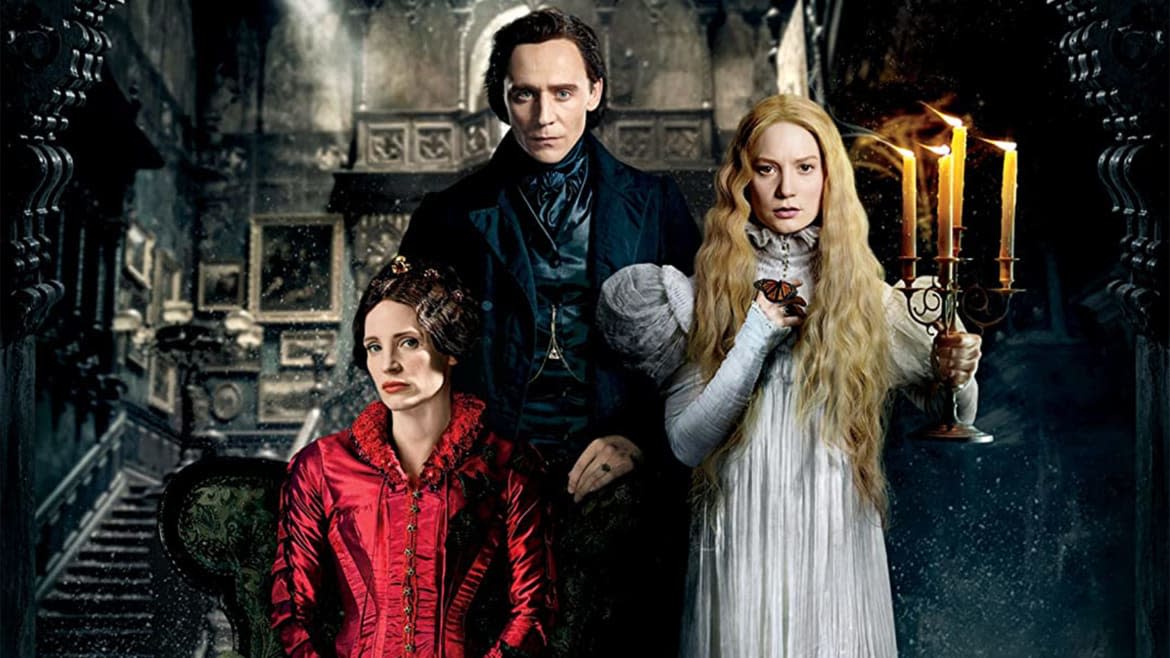Let’s Make 2020 the Year ‘Crimson Peak’ Finally Gets Its Due

- Oops!Something went wrong.Please try again later.
Crimson Peak never got the respect it deserved.
Guillermo del Toro’s snowy, blood-soaked horror mystery gave us everything we could have asked for: Mia Wasikowska in a puffy period nightgown and fantastical, flouncing wigs; a sultry, brooding Tom Hiddleston still relatively fresh off Jim Jarmusch’s fantastic vampire flick Only Lovers Left Alive; and, in its most exciting choice, an icy Jessica Chastain, buttoned to her ears in imposing period gowns and collars.
The film never really sparked at the box office or made much of a lasting mark on the culture—partially because of a marketing campaign that missed the mark. Friday marked the fifth anniversary of the film’s 2015 debut—which makes this year the perfect time to change that.
Although Crimson Peak doesn’t feel particularly “timely” right now, it does fit in well among this fall’s entertainment. It is, after all, a gothic romance in the same tradition as Haunting of Bly Manor, and inspired by Rebecca—a Hitchcock classic that Netflix also just remade with Armie Hammer and Lily James.
“Ghosts are real,” Mia Wasikowska’s bookish heroine, Edith Cushing, says at the start of Crimson Peak. “This much I know.”
The first ghost Edith ever saw was that of her mother—a specter who has warned her repeatedly since she was a little girl about the not-so-sanguine place that gives the film its name.
But Edith is not particularly haunted as we follow her, now a young woman and an aspiring author, 14 years later through the muddy streets of New York. She’s on her way to her father’s office to type up her manuscript so the editors of the Atlantic don’t know the submission is written by a woman. She soon meets a somber, penniless aristocrat named Thomas Sharpe (Hiddleston), who’s pitching her father on a machine that will help him extract the valuable scarlet clay that’s been nearly depleted from his estate. Thomas’s older sister, Lucille (Chastain), is looming and severe—always clad in solid blacks and reds, giving speeches about dead butterflies and the black moths that feast on their remains.
Guillermo del Toro on the Drug War: ‘Every Time Somebody Uses Drugs, It’s Like Having a Gun’
Edith’s father is not impressed with the pair—but Edith is. And after her father’s swift, untimely death, Edith marries Thomas and returns with him to Allendale Hall, where the movie’s hauntings truly begin.
Del Toro makes full use of Wasikowska’s dreamy, uncanny appeal, practically aging her character backwards as she struggles for her autonomy. At the start of the film, the camera captures every mature angle of Wasikowska’s face; spectacles, a physical extension of the film’s interest in eyes and ophthalmology as symbols for wisdom and perspective, make her appear older. But as soon as she arrives at Allendale Hall, Edith begins drowning in nightgowns—weighed down by giant, doll-like wigs that dwarf her almost as much as the furniture. (In one pivotal scene, Wasikowska sobs on a chair that’s almost large enough to look like a Goldilocks illustration.)
Crimson Peak’s reference points are plentiful and diverse—a Frankenstein-like blend of mystery, thriller, noir, and horror influences that include Nosferatu and The Shining, as well as Hitchcock’s Notorious and Suspicion. It’s a film obsessed with one of del Toro’s pet fascinations: love, and the spiritual corrosion that blooms in its absence, as exemplified by Thomas and Lucille’s toxic bond with one another. It is both literary and highly legible—designed to be read with ease.
Perhaps above all, one can say that Crimson Peak is allergic to subtlety. At times that’s a strength; del Toro’s willingness to lay the dramatic tension on comically thick in the film’s first act, as Edith falls head over heels for Thomas, creates comedy where a more pretentious film might’ve felt tedious. And by the end, Chastain’s unhinged performance runs away with the show. At other points, though, a little more coyness would have come in handy; in an ironic twist, the least compelling facet of this ghost movie are the actual ghosts, rendered in glossy computer animation that looks gauche next to the gorgeously executed practical effects.
That said, it cannot be overstated how stunning Crimson Peak’s visuals are. Production designer Thomas E. Sanders’s haunted house is a shadowy fortress decorated in decay. Its ceiling has caved in to the elements, allowing the seasons—autumn leaves, winter snow—to mark the unstoppable passage of time on the rotting floors below. The mansion is sinking, its floors sagging to reveal the oozing clay beneath. Doused in emerald greens and rusty reds, the house—like its owners—is eroded decadence incarnate. Its drafty breaths are a groaning nod to a past that refuses to let go.
With so many of us trapped at home for far longer than we’d like, there’s something to be said for a lusciously designed chamber piece that explores, among many themes, love and isolation. And thanks to the not-so-scary ghosts, even the most sensitive of horror viewers can watch with confidence. In other words: There’s no excuse not to give this ghost story a chance to haunt you.
Crimson Peak is available to stream on Cinemax, and to rent on Amazon.
Get our top stories in your inbox every day. Sign up now!
Daily Beast Membership: Beast Inside goes deeper on the stories that matter to you. Learn more.

